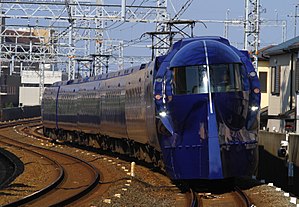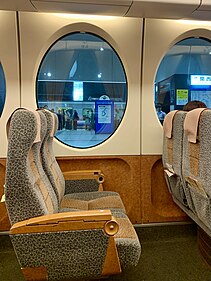Rapi:t: Difference between revisions
remove unsourced claim that it is german |
|||
| Line 38: | Line 38: | ||
[[image:Nankai 50000 series 201405040809 Neo Xeon.jpg|thumb|A ''Rapi:t'' train repainted in a red ''[[Mobile Suit Gundam Unicorn|Gundam Neo Zeon]]'' livery to mark the 20th anniversary]] |
[[image:Nankai 50000 series 201405040809 Neo Xeon.jpg|thumb|A ''Rapi:t'' train repainted in a red ''[[Mobile Suit Gundam Unicorn|Gundam Neo Zeon]]'' livery to mark the 20th anniversary]] |
||
{{nihongo|'''''Rapi:t'''''|ラピート|rapiito|extra= stylized as '''''rapiːt'''''}} is a limited express train service between [[Kansai International Airport]] and [[Namba Station]] in [[Osaka, Osaka|Osaka]], [[Japan]]. It is operated by [[Nankai Electric Railway]], and the train service uses the [[Nankai Main Line]] and the [[Nankai Airport Line|Airport Line]] |
{{nihongo|'''''Rapi:t'''''|ラピート|rapiito|extra= stylized as '''''rapiːt'''''}} is a limited express train service between [[Kansai International Airport]] and [[Namba Station]] in [[Osaka, Osaka|Osaka]], [[Japan]]. It is operated by [[Nankai Electric Railway]], and the train service uses the [[Nankai Main Line]] and the [[Nankai Airport Line|Airport Line]]. |
||
The futuristic and [[Retro style|retro-style]] six-car ''Rapi:t'' train sets, officially designated as the [[Nankai 50000 series]], were designed by architect [[Wakabayashi Hiroyuki]] and won the Blue Ribbon Prize in 1995, one year after entering service.{{citation needed|date=March 2018}}. Though the ''Rapi:t'' is one of the fastest and most convenient ways to travel from the airport to downtown Osaka, these trains are not covered by the Japan Rail Pass. Passengers traveling with a Japan Rail Pass should take either the Kansai Airport Limited Express ''[[Haruka (train)|Haruka]]'' or the ''Kansai Airport Rapid Service'' to [[Tennoji Station]] and transfer to the [[Yamatoji Line]] to [[JR Namba Station]].<ref>{{Cite web|last=|first=|date=|title=TrainReview's Guide to the Nankai Railway's Rap:t Trains|url=https://trainreview.com/train/nankai-rapt|url-status=live|archive-url=|archive-date=|access-date=|website=TrainReview}}</ref> |
The futuristic and [[Retro style|retro-style]] six-car ''Rapi:t'' train sets, officially designated as the [[Nankai 50000 series]], were designed by architect [[Wakabayashi Hiroyuki]] and won the Blue Ribbon Prize in 1995, one year after entering service.{{citation needed|date=March 2018}}. Though the ''Rapi:t'' is one of the fastest and most convenient ways to travel from the airport to downtown Osaka, these trains are not covered by the Japan Rail Pass. Passengers traveling with a Japan Rail Pass should take either the Kansai Airport Limited Express ''[[Haruka (train)|Haruka]]'' or the ''Kansai Airport Rapid Service'' to [[Tennoji Station]] and transfer to the [[Yamatoji Line]] to [[JR Namba Station]].<ref>{{Cite web|last=|first=|date=|title=TrainReview's Guide to the Nankai Railway's Rap:t Trains|url=https://trainreview.com/train/nankai-rapt|url-status=live|archive-url=|archive-date=|access-date=|website=TrainReview}}</ref> |
||
Revision as of 21:23, 17 August 2023
This article needs additional citations for verification. (July 2022) |
 A Nankai 50000 series Rapi:t train in October 2017 | |
| Overview | |
|---|---|
| Service type | Airport rail link (Limited express) |
| Status | Operating |
| Locale | Osaka Prefecture, Japan |
| First service | 4 September 1994 |
| Current operator(s) | Nankai Electric Railway Co., Ltd. |
| Route | |
| Termini | Namba Kansai Airport |
| Stops | 4 ( 6 ( |
| Line(s) used | Nankai Main Line, Airport Line |
| Technical | |
| Rolling stock | 50000 series EMUs |
| Track gauge | 1,067 mm (3 ft 6 in) |
| Electrification | 1,500 V DC, overhead line |
| Operating speed | 120 km/h (75 mph) |

Rapi:t (ラピート, rapiito, stylized as rapiːt) is a limited express train service between Kansai International Airport and Namba Station in Osaka, Japan. It is operated by Nankai Electric Railway, and the train service uses the Nankai Main Line and the Airport Line.
The futuristic and retro-style six-car Rapi:t train sets, officially designated as the Nankai 50000 series, were designed by architect Wakabayashi Hiroyuki and won the Blue Ribbon Prize in 1995, one year after entering service.[citation needed]. Though the Rapi:t is one of the fastest and most convenient ways to travel from the airport to downtown Osaka, these trains are not covered by the Japan Rail Pass. Passengers traveling with a Japan Rail Pass should take either the Kansai Airport Limited Express Haruka or the Kansai Airport Rapid Service to Tennoji Station and transfer to the Yamatoji Line to JR Namba Station.[1]
Station stops
There are two classes of Rapi:t services. Rapi:t
4
- Rapi:t
α : Namba Station - Shin-Imamiya Station - Tengachaya Station - Izumisano Station - Rinkū Town Station - Kansai Airport Station - Rapi:t
β : Namba Station - Shin-Imamiya Station - Tengachaya Station - Sakai Station - Kishiwada Station - Izumisano Station - Rinkū Town Station - Kansai Airport Station
History

The Rapi:t service was inaugurated on 4 September 1994 using 6-car Nankai 50000 series EMUs.
Rapi:t services were suspended on 4 September 2018 due to the effects of Typhoon Jebi causing damage to the airport and the Sky Gate Bridge R being damaged by an empty fuel tanker. Services to the airport were completely restored on 18 September 2018.
See also
- Haruka, limited-express service operated by JR West to Kansai Airport
References
- ^ "TrainReview's Guide to the Nankai Railway's Rap:t Trains". TrainReview.
{{cite web}}: CS1 maint: url-status (link)
External links
- Kansai International Airport access - Nankai Railway Official Website in English "How to enjoy Osaka"
